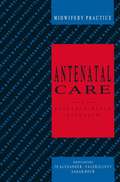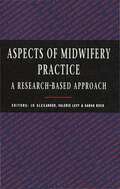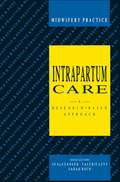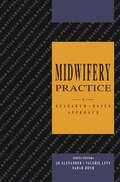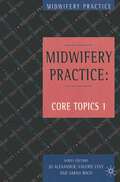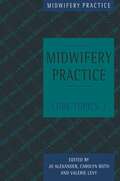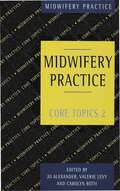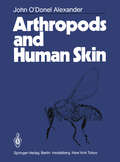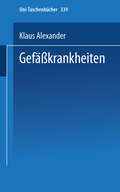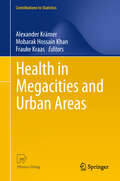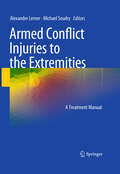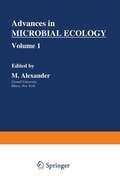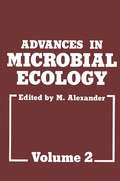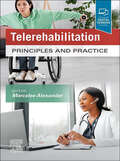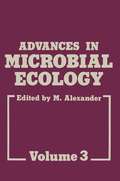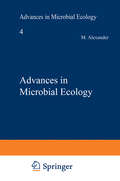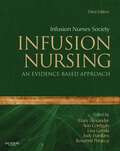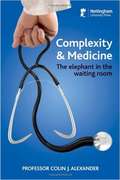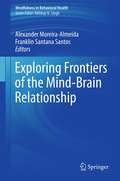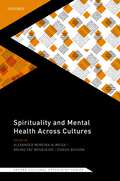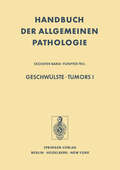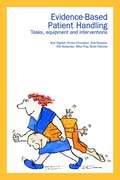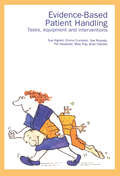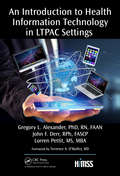- Table View
- List View
Aspects of Midwifery Practice
by Jo Alexander Valerie Levy Sarah RochThis fifth volume in the immensely popular series introduces new topics of Midwifery Practice and revisits some topics already discussed in previous volumes. The accessible chapter structure remains the same and a broad range of research themes are presented across the three stages of midwifery practice. The guiding philosophy behind this series is to present research topics within the context of clinical practice and in this volume the editors have put together a subject range which will be of interest to all practicing midwives and students.
Midwifery Practice: A Research-Based Approach
by Jo Alexander Valerie Levy Sarah RochThis latest volume in the immensely popular Midwifery Practice Series deals with a further set of important issues, this time drawn from all three stages of care during pregnancy. The chapter structure adopted in the first three books is retained, and, as before, presentation of a broad-ranging survey and analysis of key research literature placed in the context of clinical practice is the guiding philosophy behind the whole book.
Midwifery Practice: Core Topics 1: Antenatal (Midwifery Practice #Vol. 4)
by Jo Alexander Valerie Levy Sarah RochModern midwifery practice should be based on the findings of up-to-date research, which is necessarily changing and dynamic. The Midwifery Practice Series was specifically designed to enable busy practitioners and students to have access to a broad-ranging survey and analysis of the literature in a form that draws out the research-based implications for practice. With the Core Topics' books the Midwifery Practice series is relaunched and updated. The latest research findings and the implications for midwifery care in the wake of the 'Changing Childbirth' report are considered, along with seminal earlier work. The relationship between critically reviewed research findings and good practice remains essential.
Midwifery Practice: Core Topics 3: Postnatal (Midwifery Practice)
by Jo Alexander Valerie Levy Carolyn RothThe latest volume in this series revisits topics particularly pertinent to the postnatal period. It makes a timely contribution to the literature in the context of recent developments in the organisation of midwifery care, the emphasis on woman-centred care and empowerment, and the reclaiming by midwives of the normal birth and puerperium.
Midwifery Practice: Core Topics 2: Birth (Midwifery Practice #Vol. 4)
by Jo Alexander Valerie Levy Carolyn RothThis second Core Topics volume specially refers to labour and delivery. The latest findings and the implications for modern midwifery are considered, along with earlier work. The relationship between critically renewed research studies and good practice remains.
Arthropods and Human Skin
by John O'Donel AlexanderTo the entomologist all insects have six legs; the layman tends to use the term "insect" to include the eight-legged spiders and mites. All these creatures are correctly classified as arthropods. Many thousands of the hundreds of thousands of recognised species of arthropods are found in the human environment-domestic, occupational and rec reational. Those species which are obligate parasites of man, the human scabies mite and the head and body lice, produce familiar clinical syndromes. They remain important in medical practice and have been the subject of a great deal of recent research. This is beginning to throw much light on the immunological mechanisms which largely determine the reactions of the host. Dr. Alexander has provided a detailed survey of this work. The wasps, bees, ants and other Hymenoptera which may sting man in self-defence can cause painful, even fatal reactions. The recent work on this important subject has also been thoroughly reviewed. Every dermatologist of experience will admit that he sees many patients in whom he makes a diagnosis of "insect bites", if he has the confidence to do so, or of "papular urticaria" or "prurigo" when he lacks such confidence, mainly because he is at a loss to know which arthropod is likely to be implicated. In his survey of the enormous literature in the entomological, public health and dermatology journals Dr. Alexander has provided an invaluable guide in which the solutions to these clinical mysteries can be sought.
Gefäßkrankheiten: Kurzgefaßte Diagnostik und Therapie (Universitätstaschenbücher #339)
by K. AlexanderDas Wesen des ärztlichen Denkens und der klinischen Wissenschaft ist, verschiedene Methoden gleichzeitig für Analyse und Verständnis von Krankheitssymptomen anzuwenden und das Beobachtete unter möglichst vielen Gesichtspunkten auszuwerten. Das Spannungsfeld ärztlichen Denkens hat sich nach allen Seiten geweitet. Es reicht heute von der makromolekularen Dimension bis zu den sozialen und indivi duellen Determinanten menschlichen Daseins. Dem Arzt ist die Auf gabe gestellt, dem analytischen Detail den richtigen Stellenwert in einem Geschehen zuzuordnen, das sich in der uns natürlich vorgege benen Größenordnung, einem lebendigen Mitmenschen, abspielt. Wi/liam Harvey war fasziniert, daß die von ihm beobachteten Tat sachen sich zum Ganzen eines Kreislaufs zusammenfügten. Die Ver teilung der Lebenskraft im Körper geschah nach dem Modell der voll kommenen geometrischen Figur des Kreises. Die physiologische und die ihr folgende klinische Forschung arbeitete die Feinheiten dieser Kreisbewegung aus und rückte die Idee des Ganzen in den Hinter grund. Es bildeten sich Forschungsgebiete und ihr entsprechende wissenschaftliche Gesellschaften für Kardiologie, Angiologie - eigent lich Arteriologie - Phlebologie, Mikrozirkulation und Lymphangiologie. Die Erforschung des kleinen Kreislaufs, des Pfortaderkreislaufs, der Eigenart der Regelung der Durchblutung von Niere, Gehirn, Auge, machten besondere gedankliche und methodische Ansätze notwendig. Der Arzt geht von der komplexen Wirklichkeit der sich ihm spontan darbietenden Krankheitsphänomene aus und kehrt spätestens anläß lich von therapeutischen und prognostischen überlegungen zu ihnen zurück. Das Ganze - hier der Kreislauf - ist für ihn nicht Idee, sondern Wirklichkeit.
Health in Megacities and Urban Areas (Contributions to Statistics)
by Alexander Krämer, Mobarak Hossain Khan and Frauke KraasDiverse driving forces, processes and actors are responsible for different trends in the development of megacities and large urban areas. Under the dynamics of global change, megacities are themselves changing: On the one hand they are prone to increasing socio-economic vulnerability due to pronounced poverty, socio-spatial and political fragmentation, sometimes with extreme forms of segregation, disparities and conflicts. On the other hand megacities offer positive potential for global transformation, e.g. minimisation of space consumption, highly effective use of resources, efficient disaster prevention and health care options – if good strategies were developed. At present in many megacities and urban areas of the developing world and the emerging economies the quality of life is eroding. Most of the megacities have grown to unprecedented size, and the pace of urbanisation has far exceeded the growth of the necessary infrastructure and services. As a result, an increasing number of urban dwellers are left without access to basic amenities like clean drinking water, fresh air and safe food. Additionally, social inequalities lead to subsequent and significant intra-urban health inequalities and unbalanced disease burdens that can trigger conflict and violence between subpopulations. The guiding idea of our book lies in a multi- and interdisciplinary approach to the complex topic of megacities and urban health that can only be adequately understood when different disciplines share their knowledge and methodological tools to work together. We hope that the book will allow readers to deepen their understanding of the complex dynamics of urban and megacity populations through the lens of public health, geographical and other research perspectives.
Armed Conflict Injuries to the Extremities: A Treatment Manual
by Alexander Lerner and Michael SoudryThis book is designed to meet the continued need to re-learn the principles of treatment of complex war injuries to the extremities in order to minimize post-traumatic and post-treatment complications and optimize functional recovery. Most of the chapters are based on the unique experience gained in the treatment of military personnel who have suffered modern combat trauma and civilian victims of terror attacks at a single, large level 1 trauma center. The remaining chapters present the experience of leading international authorities in trauma and reconstructive surgery. A staged treatment protocol is presented, ranging from primary damage control through to definitive functional limb reconstruction. The organization of medical aid, anesthesiology, diagnostic imaging, infection prophylaxis, and management of complications are reviewed, and a special chapter is devoted to the challenging dilemma of limb salvage versus amputation in the treatment of limbs at risk.
Advances in Microbial Ecology (Advances in Microbial Ecology #1)
by M. AlexanderMicrobial ecology has come of age. A long history of exploratory research and problem definition is admittedly behind us, and outstanding scientists from many regions of the world have contributed major findings to the development of the discipline. The early literature is indeed vast and impressive, yet it is still fair to say that the field is just beginning to develop in a mature fashion. The major microbial habitats and the chief inhabitants have been delineated and are only now being adequately explored; the processes that are brought about by the microscopic residents are at the present time being investigated in definitive ways; new concepts are being formulated; and novel, exciting, and useful techniques have been devised. In recognition of the emergence of microbial ecology as a rapidly growing and independent discipline, the International Commission on Microbial Ecology-a unit of the International Association of Micro biological Societies and the Division of Environmental Biology of the Inter national Union of Biological Societies-has established the Advances in Microbial Ecology and has appointed an editor and editorial board for the series. The purposes of this review series are to present in one group of volumes an overview of the information that is now spread in an enormous array of technical journals, to have authors in various areas of microbial ecology summarize and present views in depth of their own specialties, and to help promote the continued growth of microbial ecology.
Advances in Microbial Ecology: Volume 2 (Advances in Microbial Ecology #2)
by M. AlexanderThe substantial and impressive changes in microbial ecology can scarcely be chronicled in a meaningful fashion, and a review series such as Advances in Microbial Ecology can thus not do justice to the numerous studies that have been published in recent years. On the other hand, the mere existence of this series bears testimony to the many and diverse activities. The growing concern with microbial communities and processes in natural ecosystems is not restricted to scientists in one region and is not limited to particular groups of organisms or to individual theoretical or applied problems. The recent and successful international symposium on microbial ecology held in New Zealand-sponsored in part by the International Commission on Microbial Ecology, as is the Advances-and the general microbiology and ecology conferences and congresses have included reports from investigators from all corners of the globe and have explored both new and traditional areas, agricultural and public health problems, individual species and complex communities, and heterotrophs and autotrophs as well as ecosystem models relying on mathematical concepts and environmental processes needing sophisticated chemistry for their definition. The reviews in the present volume thus can offer only a minute sampling of the multitude of topics being actively explored at the present time. Two of the reviews focus attention on biogeochemical cycles regulated by microorganisms, in particular the way these organisms contribute to or control the levels and identities of chemical substances in the atmosphere. The chapter by Y. Dommergues, L. W. Belser, and E. L.
Telerehabilitation, E-Book: Principles and Practice
by Marcalee AlexanderOffering significant benefits to both healthcare providers and patients, telerehabilitation is a key component in the future of rehabilitation care. Telerehabilitation: Principles and Practice provides expert information from experienced practitioners in the field, covering the wide range of patients seen in a rehabilitation medical practice or a hospital-based system. It provides quick access to information on common rehabilitation diagnoses and practices and how you can best use telerehabilitation to provide timely, effective care to every patient. Clearly explains the benefits and utility of telerehabilitation for improving access to care and outcomes for various patient populations. Uses a reader-friendly format based on diagnosis of specific disorders and common problems. Covers telerehabilitation for spinal cord injury, stroke, and cancer rehabilitation, amongst other diagnoses. Discusses key topics in telerehabilitation such as musculoskeletal concerns, integrative health, physical and occupational therapy. Features discussions of the use of telerehabilitation for care of psychologic, bladder, bowel, and sexual concerns. Ideal for telemedicine professionals, physiatrists in practice or residency administrators, as well as physical and occupational therapists.
Advances in Microbial Ecology: Volume 3 (Advances in Microbial Ecology #3)
by Martin AlexanderWe are most gratified by the response to the initiation of this series of volumes presenting recent developments and new concepts in microbial ecology. Favorable reactions have been expressed in both oral and written communication, and Ad vances in Microbial Ecology thus seems to be providing a worthwhile outlet in a rapidly growing field of microbiology and environmental sciences. The growing importance of microbial ecology is evident in many ways. Uni versity personnel are expanding their programs and increasing the number of research topics and publications. Substantial numbers of industrial scientists have likewise entered this field as they consider the microbial transformation of chemicals in waters and soils and the effects of synthetic compounds on natural microbial communities. Agricultural, medical, dental, and veterinary practitioners and scientists have also been increasing their activity in microbial ecology because of the importance of the discipline to their own professions. In addition, govern mental agencies have expanded regulatory and research activities concerned with microbial ecology owing to the importance of information and regulations fo cused on the interactions between microorganisms in nature and particular en vironmental stresses.
Advances in Microbial Ecology (Advances in Microbial Ecology #4)
by Martin AlexanderThe literature in microbial ecology is growing rapidly. Journals in many countries dealing with microbiology, ecology, environmental sciences, and environmental technology are publishing an ever-increasing number of papers, and these reports are providing microbial ecologists with a wealth of information. This body of data is now so large and the research is published in so many journals and mono graphs that maintaining an overview of the development of the field grows more difficult. The role of Advances in Microbial Ecology thus becomes more obvious with time. The articles in the present volume encompass an array of topics appropriate to the development of the discipline of microbial ecology. Both terrestrial and aquatic ecosystems are subjects of attention, and a variety of microbiological groups come under review. Furthermore, methodological problems and ap proaches are not overlooked. The ecology of protozoa, constraints on their populations, and their role in nutrient cycling and energy flow are considered by J. D. Stout. A unique micro environment is discussed by B. Norkrans, the surface microlayer of aquatic eco systems, and Dr. Norkrans presents information on a field that has blossomed in the last few years. The subject of the review by H. S. Lowendorf is the genus Rhizobium, a group of bacteria whose importance has grown as the cost of fuel for production of nitrogen fertilizers and ultimately for protein production has increased.
Infusion Nursing - E-Book: An Evidence-Based Approach
by Mary Alexander Infusion Nurses Society Ann Corrigan Lisa Gorski Judy Hankins Roxanne PeruccaWith a new focus on evidence-based practice, the 3rd edition of this authoritative reference covers every aspect of infusion therapy and can be applied to any clinical setting. Completely updated content brings you the latest advances in equipment, technology, best practices, guidelines, and patient safety. Other key topics include quality management, ethical and legal issues, patient education, and financial considerations. Ideal as a practical clinical reference, this essential guide is also a perfect review tool for the CRNI examination.Authored by the Infusion Nurses Society, this highly respected reference sets the standard for infusion nursing practice. Coverage of all 9 core areas of INS certification makes this a valuable review resource for the examination. Material progresses from basic to advanced to help new practitioners build a solid foundation of knowledge before moving on to more advanced topics. Each chapter focuses on a single topic and can serve as a stand-alone reference for busy nursing professionals. Expanded coverage of infusion therapy equipment, product selection, and evaluation help you provide safe, effective care. A separate chapter on infusion therapy across the continuum offers valuable guidance for treating patients with infusion therapy needs in outpatient, long-term, and home-care, as well as hospice and ambulatory care centers. Extensive information on specialties addresses key areas such as oncology, pain management, blood components, and parenteral nutrition. An evidence-based approach and new Focus on Evidence boxes throughout the book emphasize the importance of research in achieving the best possible patient outcomes.The user-friendly design highlights essential information in handy boxes, tables, and lists for quick access. Completely updated coverage ensures you are using the most current infusion therapy guidelines available.
Complexity and medicine: The Elephant in the Waiting Room
by Michael AlexanderThis book takes Complexity Theory and applies it to medicine where it has previously made little ground. It provides new hypotheses for multiple common but misunderstood diseases.
Exploring Frontiers of the Mind-Brain Relationship (Mindfulness in Behavioral Health)
by Alexander Moreira-Almeida and Franklin Santana SantosThe conscious mind defines human existence. Many consider the brain as a computer, and they attempt to explain consciousness as emerging at a critical, but unspecified, threshold level of complex computation among neurons. The brain-as-computer model, however, fails to account for phenomenal experience and portrays consciousness as an impotent, after-the-fact epiphenomenon lacking causal power. And the brain-as-computer concept precludes even the remotest possibility of spirituality. As described throughout the history of humankind, seemingly spiritual mental phenomena including transcendent states, near-death and out-of-body experiences, and past-life memories have in recent years been well documented and treated scientifically. In addition, the brain-as-computer approach has been challenged by advocates of quantum brain biology, who are possibly able to explain, scientifically, nonlocal, seemingly spiritual mental states.Exploring Frontiers of the Mind-Brain Relationship argues against the purely physical analysis of consciousness and for a balanced psychobiological approach. This thought-provoking volume bridges philosophy of mind with science of mind to look empirically at transcendent phenomena, such as mystic states, near-death experiences and past-life memories, that have confounded scientists for decades. Representing disciplines ranging from philosophy and history to neuroimaging and physics, and boasting a panel of expert scientists and physicians, including Andrew Newberg, Peter Fenwick, Stuart Hameroff, Mario Beauregard, Deepak Chopra, and Chris Clarke the book rigorously follows several lines of inquiry into mind-brain controversies, challenging readers to form their own conclusions—or reconsider previous ones. Key coverage includes: Objections to reductionistic materialism from the philosophical and the scientific tradition.Phenomena and the mind-brain problem.The neurobiological correlates of meditation and mindfulness.The quantum soul, a view from physics.Clinical implications of end-of-life experiences.Mediumistic experience and the mind-brain relationship. Exploring Frontiers of the Mind-Brain Relationship is essential reading for researchers and clinicians across many disciplines, including cognitive psychology, personality and social psychology, the neurosciences, neuropsychiatry, palliative care, philosophy, and quantum physics.“This book … brings together some precious observations about the fundamental mystery of the nature of consciousness … It raises many questions that serve to invite each of us to be more aware of the uncertainty of our preconceptions about consciousness … This book on the frontiers of mind-body relationships is a scholarly embodiment of creative and open-minded science.”C. Robert Cloninger, MDWallace Renard Professor of Psychiatry, Genetics, and Psychology,Washington University School of MedicineSt. Louis MO
Spirituality and Mental Health Across Cultures (Oxford Cultural Psychiatry)
by Alexander Moreira-Almeida, Bruno Paz Mosqueiro, Dinesh BhugraReligiosity and spirituality (R/S) represent a very important factor of daily life for many individuals across different cultures and contexts. It is associated with lower rates of depression, suicide, mortality, and substance abuse, and is positively correlated with well-being and quality of life. Despite growing academic recognition and scientific literature on these connections this knowledge has not been translated into clinical practice. Part of the expanding Oxford Cultural Psychiatry series, Spirituality and Mental Health Across Cultures is a timely exploration of the implications of R/S on mental health. Written and edited by 38 experts in the fields of spirituality and mental health from 11 countries, covering a wide range of cultural and geographical perspectives, this unique resource assesses how mental health relates to world religions, agnosticism, atheism, and spiritualism unaffiliated with organised religion, with a practical touch. Across 25 chapters, this resource provides readers with a succinct and trustworthy review of the latest research and how this can be applied to clinical care. The first section covers the principles and fundamental questions that relate science, history, philosophy, neuroscience, religion, and spirituality with mental health. The second section discusses the main beliefs and practices related to world religions and their implications to mental health. The third reviews the impact of R/S on specific clinical situations and offers practical guidance on how to handle these appropriately, such as practical suggestions for assessing and integrating R/S in personal history anamnesis or psychotherapy.
Geschwülste / Tumors I: Morphologie, Epidemiologie, Immunologie / Morphology, Epidemiology, Immunology (Handbuch der allgemeinen Pathologie #6 / 5)
by P. Alexander G. Chomette H. Hamperl D. K. Hossfeld L. G. Koss R. Laumonier H. F. Oettgen M. F. Rajewsky A. A. Sandberg L. H. Sobin H. Tulinius S. WatanabeEvidence-Based Patient Handling: Techniques and Equipment
by Pat Alexander Emma Crumpton Brian Fletcher Mike Fray Sue Hignett Sue RuszalaProviding care and treatment for patients usually requires moving and handling activities associated with high rates of back injuries. The personal and financial cost of back pain and injuries to health staff means there is an urgent need to improve practice in this area. Over the past twenty years a number of guidelines have been published, however, these have been based on professional consensus rather than evidence. Evidence-Based Patient Handling tackles the challenge of producing an evidence base to support clinical practice and covers tasks, equipment and interventions. This book questions previously held opinions about moving and handling and provides the foundation for future practice.
Evidence-Based Patient Handling: Techniques and Equipment
by Pat Alexander Emma Crumpton Brian Fletcher Mike Fray Sue Hignett Sue RuszalaProviding care and treatment for patients usually requires moving and handling activities associated with high rates of back injuries. The personal and financial cost of back pain and injuries to health staff means there is an urgent need to improve practice in this area. Over the past twenty years a number of guidelines have been published, however, these have been based on professional consensus rather than evidence. Evidence-Based Patient Handling tackles the challenge of producing an evidence base to support clinical practice and covers tasks, equipment and interventions. This book questions previously held opinions about moving and handling and provides the foundation for future practice.
An Introduction to Health Information Technology in LTPAC Settings (HIMSS Book Series)
by Gregory L. Alexander, PhD, RN, FAAN Derr F. John, RPh, FASCP Lorren Pettit, MS, MBAA multiplicity of factors converging together suggest the long term/post-acute care (LTPAC) provider community (e.g. nursing homes, behavioral health facilities, home health agencies, etc.) will accelerate in importance within the healthcare ecosystem during the next few years. The challenge for many LTPAC providers in this emerging environment will be to advance their clinical health information technologies (health IT) capabilities in order to "play" with other providers in the healthcare "sandbox." This book is designed to assist LTPAC leaders in identifying and exploring the array of critical issues one needs to consider in order to operate within an advanced clinical health IT ecosystem. This book surveys key issues surrounding the use of clinical health IT in LTPAC settings, to include providing readers with a suggested strategic plan and roadmap for selecting and installing digital health technologies in LTPAC organizations. Though the focus of the book primarily centers on the U.S. LTPAC provider’s experience, the authors also spend time addressing global and future LTPAC considerations.
An Introduction to Health Information Technology in LTPAC Settings (HIMSS Book Series)
by Gregory L. Alexander, PhD, RN, FAAN Derr F. John, RPh, FASCP Lorren Pettit, MS, MBAA multiplicity of factors converging together suggest the long term/post-acute care (LTPAC) provider community (e.g. nursing homes, behavioral health facilities, home health agencies, etc.) will accelerate in importance within the healthcare ecosystem during the next few years. The challenge for many LTPAC providers in this emerging environment will be to advance their clinical health information technologies (health IT) capabilities in order to "play" with other providers in the healthcare "sandbox." This book is designed to assist LTPAC leaders in identifying and exploring the array of critical issues one needs to consider in order to operate within an advanced clinical health IT ecosystem. This book surveys key issues surrounding the use of clinical health IT in LTPAC settings, to include providing readers with a suggested strategic plan and roadmap for selecting and installing digital health technologies in LTPAC organizations. Though the focus of the book primarily centers on the U.S. LTPAC provider’s experience, the authors also spend time addressing global and future LTPAC considerations.
